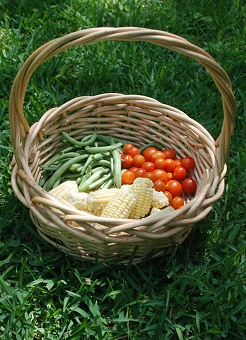Remember that garden post from May 11? Well, we’ve had tiny harvests since then–a few radishes, enough beans for a small “mess” of them–but today was the first Grand Prize for home gardeners–enough corn, beans, and tomatoes for a meal for two.

Oh, happy taste buds! Happy stomachs! The Chief Gardener said this made the work worth it. Hurray!
And yes, a lot of wildlife have enjoyed the garden as well, from bugs to birds. (So far the deer haven’t discovered it…)
Comment by Adrianne Middleton — May 27, 2009 @ 12:23 pm
Lovely!!!
Our local farms won’t have anything beyond asparagus and spinach and strawberries for 3 weeks yet. I’m jealous!
A
Comment by Marjorie Procter-Smith — May 27, 2009 @ 7:17 pm
My mouth is watering. Congratulations to the Chief Gardener!
Your garden is well ahead of ours. Tomatoes and eggplant and peppers have small fruit on them, but nothing ready to pick. We did dig elephant garlic this week, and have been pulling onions for the last couple of weeks. I’m particularly envious of the corn; that looks like sweet corn, which many information sources say you can’t grow in Texas. Obviously that’s not the case. But what variety are you growing? Any special tricks for Texas sweet corn? I’d love to try it in our garden next year! There is absolutely nothing better than fresh-picked sweet corn, as I learned when we lived in North Indiana.
Comment by elizabeth — May 27, 2009 @ 10:24 pm
You certainly *can* grow sweet corn in Texas. Like many other things, you want to grow it early in the season (at least, we always have) but we’ve grown it as far south as San Antonio. (For that matter, I think some people grew sweet corn in south Texas, where I grew up. Much of the corn was field corn, but people with vegetable gardens grew sweet corn.) Farmer’s markets around here have it.
You do need to make good soil for it, if you soil isn’t deep enough and fairly rich. And it seems to want plenty of water–let it get dry and it’ll produce a lot less.
I don’t know what variety this was–Richard got the seed at HEB. We’ve grown Silver Queen (I think that was the name of a white sweet corn) before, and another one whose name I forget (from Burpee Catalog seeds) that produced cobs with both yellow and white kernels. This was tasty, though.
E.
Comment by Marjorie Procter-Smith — May 28, 2009 @ 6:32 pm
I’m encouraged to try next spring. How early do you put it in? We started our beans early this spring (in March) and had them all wiped out by a sudden cold spell with an overnight low of 33. We have blackland prairie soil, but we amend our garden soil with rabbit manure and worm castings. Takes a couple of years of working it in, but we get a rich loose soil as a result. I’ll watch the HEB garden department next year for seeds. Oh, I love Silver Queen sweet corn!
Comment by elizabeth — May 28, 2009 @ 10:46 pm
We pretty much follow local custom here, but go as early as we can to avoid both extreme dry heat and the summer bugfest. So I expect to have to mulch and cover things. It’s interesting that your beans croaked with an overnight 33…ours survived a good hard freeze when they were maybe four inches tall–just a couple of good leaves–and I was sure they’d croak…but they didn’t. It may be that being in raised beds helped, and the windbreak hedges around the garden as well. We didn’t use a hay mulch-cover this time (hay being so scarce and the horses eating it at a great rate.) Normally I’d go out before a predicted frost or freeze and scatter hay loosely over everything while the soil was still warm (our freeze was right after a warm spell, of course.)
Anyway–spring onions go in in January, potatoes on or near Valentine’s day, and the corn and beans well into March, with an eye on the long-range forecast for both rain and freezes.